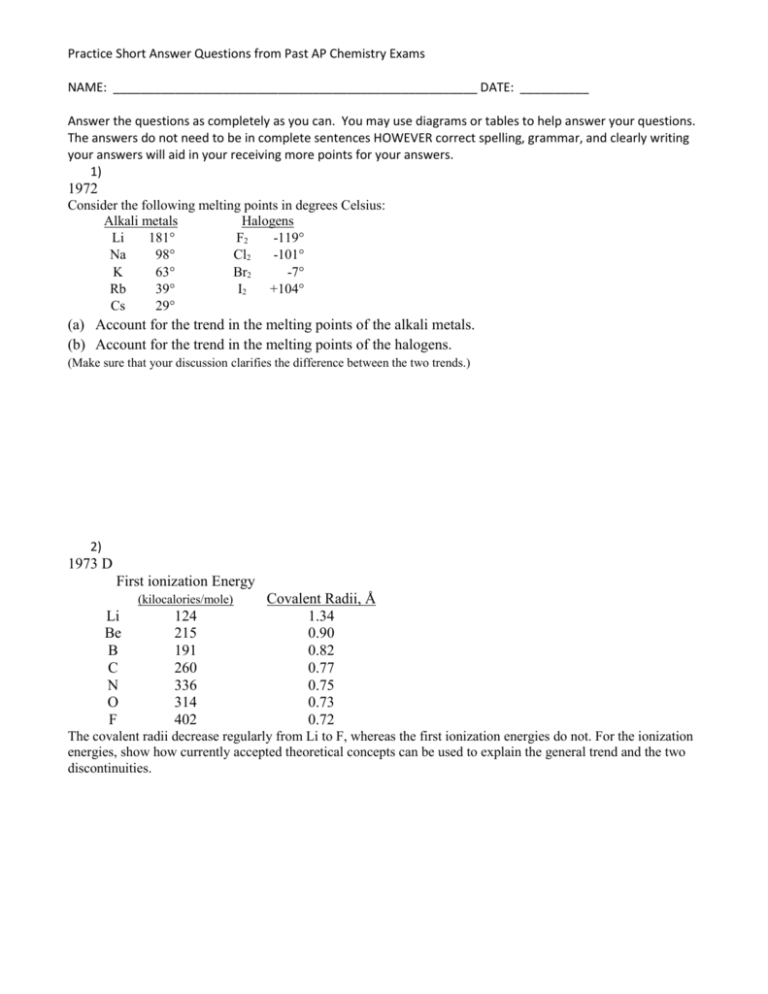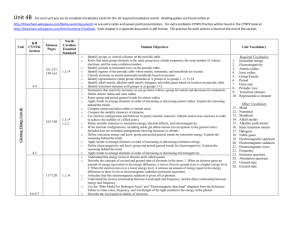Practice Short Answer Questions from Past AP Chemistry Exams for
advertisement

Practice Short Answer Questions from Past AP Chemistry Exams NAME: _____________________________________________________ DATE: __________ Answer the questions as completely as you can. You may use diagrams or tables to help answer your questions. The answers do not need to be in complete sentences HOWEVER correct spelling, grammar, and clearly writing your answers will aid in your receiving more points for your answers. 1) 1972 Consider the following melting points in degrees Celsius: Alkali metals Halogens Li 181 F2 -119 Na 98 Cl2 -101 K 63 Br2 -7 Rb 39 I2 +104 Cs 29 (a) Account for the trend in the melting points of the alkali metals. (b) Account for the trend in the melting points of the halogens. (Make sure that your discussion clarifies the difference between the two trends.) 2) 1973 D First ionization Energy (kilocalories/mole) Li Be B C N O F 124 215 191 260 336 314 402 Covalent Radii, Å 1.34 0.90 0.82 0.77 0.75 0.73 0.72 The covalent radii decrease regularly from Li to F, whereas the first ionization energies do not. For the ionization energies, show how currently accepted theoretical concepts can be used to explain the general trend and the two discontinuities. 3) 1976 D M(s) + Cl2(g) MCl2(s) The reaction of a metal with chlorine proceeds as indicated above. Indicate, with reasons for your answers, the effect of the following factors on the heat of reaction for this reaction. (a) A large radius versus a small radius for M2+ (b) A high ionization energy versus a low ionization energy for M. . 4) 1977 D The electron affinities of five elements are given below. 12 kcal/mole 13Al 32 kcal/mole 14Si 17 kcal/mole 15P 48 kcal/mole 16S 87 kcal/mole 17Cl Define the term “electron affinity” of an atom. For the elements listed above, explain the observed trend with the increase in atomic number. Account for the discontinuity that occurs at phosphorus. 5) 1984 D Discuss some differences in physical and chemical properties of metals and nonmetals. What characteristic of the electronic configuration of atoms distinguishes metals from nonmetals. On the basis of this characteristic explain why there are many more metals than nonmetals. 6) 2006 D Suppose that a stable element with atomic number 119, symbol Q, has been discovered. (a) Write the ground-state electron configuration for Q, showing only the valence-shell electrons. (b) Would Q be a metal or a nonmetal? Explain in terms of electron configuration. (c) On the basis of periodic trends, would Q have the largest atomic radius in its group or would it have the smallest? Explain in terms of electronic structure. (d) What would be the most likely charge of the Q ion in stable ionic compounds? (e) Write a balanced equation that would represent the reaction of Q with water. (f) Assume that Q reacts to form a carbonate compound. (i) Write the formula for the compound formed between Q and the carbonate ion, CO32–. (ii) Predict whether or not the compound would be soluble in water. Explain your reasoning. Answers to Practice Short Answer Questions from Past AP Chemistry Exams 1) Answer: (a) Because of their large sizes and limited numbers of valence electrons, bonding between alkali metal atoms is not as strong as in most metals. Since the atoms increase in size down the family, those near the bottom (Rb and Cs) have the greatest internuclear distances. (b) Attractive forces between halogen molecules are rather weak, (they are London forces), these forces increase in strength with increasing molecular weight (and increasing numbers of electrons). 2) Answer: 450 400 350 300 250 200 150 100 50 0 Li Be B C N O F The trend in moving across a period is that the first ionization energy, I1, increases from group 1 (Li) to group 7 (F) because of an increase in effective nuclear charge, atoms get smaller (decrease covalent radii) and less metallic through the period. The I1 is less for B than Be because the electron to be ionized in B is in a higher energy orbital (2p) than is the electron (2s) to be ionized in Be. The I1 is less for O than N because the electron to be ionized in O is a paired electron in the 2p orbitals. At N, the outer sublevel of its atom is half-filled, resulting in a symmetrical spherical electron cloud. The extra electron in O reduces this symmetry and so less energy is required to remove this electron. 3) Answer: (a) As radius increases the heat of reaction decreases (less exothermic). Less energy released by ionic attraction (lattice energy inversely proportional to distance). (b) As ionization energy increases the heat of reaction decreases (less exothermic), More energy required to form M2+ while other factors remain unchanged 4) Answer: Electron affinity - the energy released when a gaseous atom gains an electron to form an ion. As an electron is added to the same valence shell of an atom, when Z increases, the atomic radius decreases. Therefore, the added electron in going from Al to Si and from P to S to Cl is closer to the nucleus and more energy is released (electron affinity greater). Also as the atomic radius decreases, the shielding of the nucleus by the surrounding electrons is less effective, and the attraction for the added electron is greater. At P, the outer sublevel of its atom is half-filled, resulting in a symmetrical spherical electron cloud. The extra electron reduces this symmetry and so less energy is released when it enters the atom to form P-. 5) Answer: metals Physical properties: melting points rel. high elec. conduct. good luster high physical state most solids [etc.] Chemical properties: redox agents reducing electropositive oxides basic or amphoteric react with nonmetals [etc.] non-metals rel. low insulators little or none gases, liq. or solids oxid. or reducing electronegative acidic metals & non-metals Electron configurations: Metals: Valence electrons in s or d sublevels of their atoms. (A few heavy elements have atoms with one or two electrons in p sublevels.) Nonmetals: Valence electrons in the s and p sublevels of their atoms. There are more metals than nonmetals because filling d orbitals in a given energy level involves the atoms of ten elements and filling the f orbitals involves the atoms of 14 elements. In the same energy levels, the maximum number of elements with atoms receiving p electrons is six. 6) Answer: (a) 8 s1 (b) metal - It has one valence electron that it easily loses, consistent with the other alkali metals in its family. (c) Q would have the largest atomic radius in its group. Every time another s-orbital is added to an element, it creates a bigger electronic shell. (d) +1 (e) 2 Q + 2 H2O 2 Q+ + H2 + 2 OH– (f) (i) Q2CO3 (ii) soluble in water. With very few exceptions, all alkali metal salts are soluble in water.







